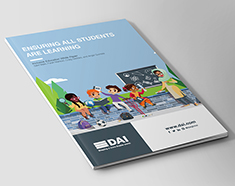DEVELOPMENTS
Here’s How We Push Ahead with Inclusive Education
Jun 9, 2020
Since discussions began around the Millennium Development Goals (MDGs), the global community has agreed that education is the right of every child, regardless of socio-economic status, religion, ability, culture, or geography. Yet even as the idea of inclusive education garners support, we struggle to move beyond talk to action. DAI hosted a panel on inclusive education in 2019 to ask two fundamental questions: What are the key policies needed to support inclusive education? And what aspects of project design and implementation are essential to achieve inclusive education?
 In a recent white paper, our Inclusive Education team makes the following recommendations for policy makers and implementers.
In a recent white paper, our Inclusive Education team makes the following recommendations for policy makers and implementers.
Download Full Report
Apply systems thinking to ensure strategic and holistic change in education at the system, societal, and school levels. In education, application of systems thinking requires an in-depth review of the local education structure, including review of:
- Instructional curriculum, both content and pedagogy
- Supportive teaching and learning materials
- Access to, and effective use of, appropriate assistive devices
- School-linked medical and health diagnosis tools
- Education-supportive social services
Do no harm. We must make a concerted effort to ensure all programming affects communities positively and that adverse knock-on effects are mitigated. In our development assistance, local government, community, religious, and traditional leaders must be involved in the design and implementation of our programs.
Accommodate a twin-track approach. Since a systems approach to inclusive education requires a significant amount of education and buy-in at the home, school, community, and government levels, applying a twin-track approach is wisest. Twin tracking allows for temporary solutions to immediate needs, as well as planning for permanent change in the system. A twin tracking approach done right will underpin all activities with a commitment to eventual mainstreaming and full inclusion, while immediately focusing activities on intervention for individual students who require assistance now.
Focus on the how. There is overwhelming consensus on why systems should be inclusive, but the political will, policy preferences, and program models—the how—is where the education community falls behind. We suggest policy makers accept and use the substantial evidence base we have, instead of asking for additional proof points or additional testing within all conceivable education environments.
Ask better data questions. While the previous point holds, and there is compelling evidence that inclusive education should be the goal, we still need better data to chart the most sustainable ways to operationalize it.
Consider new financing angles. Education reform will entail new funding efforts. Policy makers should engage disabled persons organizations and advocacy and support groups—including parents of children with disabilities or those who are socially excluded—to ensure they are a part of this funding conversation. Supporting local advocacy work may require training for local organizations that lack insight into the complexity of government funding. Policy makers and donors should also work together to think beyond “project” support, adjusting the two- to five-year timelines that we usually use for project-funded work.
Prioritize stakeholders. We need to focus on shifting mindsets, including through social and behavior change campaigns. In most target communities we serve, ingrained belief systems often exclude certain groups due to entrenched theories, folklore, or religious beliefs—perpetuating the isolation of girls, pregnant girls, children with disabilities, children of different castes or religions, or marginalized households. Implementers should build a common vocabulary with their communities, instead of having an outside “expert” come in and tell a community what will happen, using jargon or words that are unfamiliar. We cannot operationalize “all means all” without involving in the process people with disabilities and those who are socially excluded.
Apply universal design approaches. Implementers should incorporate universal design for learning into pre-service training so that new teachers enter the workforce ready to incorporate these principles in their day-to-day practice. We recommend implementers work with existing teacher training institutions and build buy-in around these principles, as well as working with local experts to create relevant curricula for pre-service instructors, so they can pass that understanding on to their pre-service teacher candidates.
Appropriate technology. Use technology appropriate for each student and in each context. In practice, this can mean using a low-tech instead of a high-tech solution and remembering that technology can mean something as simple as a grip that allows a student to better hold a pencil, or a pair of eyeglasses for a child who cannot clearly see text. Current technology offers impressive capabilities but might not be the only solution. However, in some cases, purchasing older technology is itself an upkeep risk.
Design for scale. To ensure the sustainability of investments in inclusive schools, and access for multiple users over time, implementers should be up front with communities in disclosing cost considerations and replacement needs, so that they are able to appropriately plan for scheduled maintenance and replacement costs.
These recommendations are not stand-alone solutions but related pieces of a multilayered, integrated system of decision-making, design, and implementation. For example, we cannot deliver sustainable pre-service teacher training on universal design for learning without discussions about budget and funding. We cannot build community awareness and engagement without data and evidence to share with those communities. We need to act on all these fronts, and we need to act now.